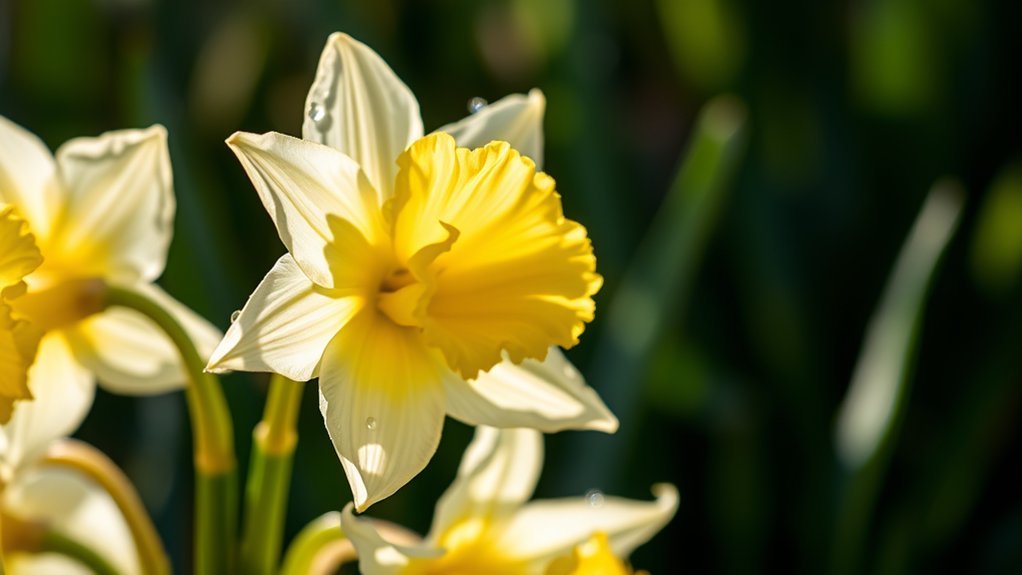March Birth Flower
The birth flowers for March are the daffodil and jonquil, each symbolizing renewal and joy. Daffodils typically bloom with vibrant yellow or white petals, representing optimism, while jonquils, with their multiple smaller flowers, convey affection. Both thrive in well-drained soil and prefer sunny spots, making them perfect for spring gardens. With rich historical significance and various interpretations based on color, these flowers serve not just as symbols, but also as thoughtful gifts. Keep exploring to uncover more fascinating details.
Key Takeaways
- The primary birth flower for March is the daffodil, symbolizing new beginnings and joy.
- Daffodils come in various colors, including yellow, white, and orange, each with distinct meanings.
- The secondary birth flower for March is the jonquil, representing affection and optimism.
- Daffodils thrive in well-drained soil and sunny spots, blooming from mid to late spring.
- Both flowers are popular choices for spring celebrations and meaningful gifts for March birthdays.
What Is the Birth Flower for March?
The vibrant daffodil reigns as the birth flower for March, embodying themes of new beginnings and joy that align perfectly with the onset of spring.
The daffodil, March's birth flower, symbolizes new beginnings and joy, perfectly reflecting the arrival of spring.
Within the Narcissus genus, the daffodil features trumpet-shaped flowers in colors like yellow, white, and orange, flourishing from early to late spring.
Alongside it, the jonquil—a specific daffodil variant—offers smaller, fragrant yellow blooms and multiple flowers per stem.
Both March birth flowers symbolize rebirth, hope, and positivity, thriving in USDA hardiness zones 3-9.
They prefer well-drained soil and sunny spots, making them ideal for gardens celebrating the changeover from winter to vibrant spring.
Why Are There Two Birth Flowers for March?
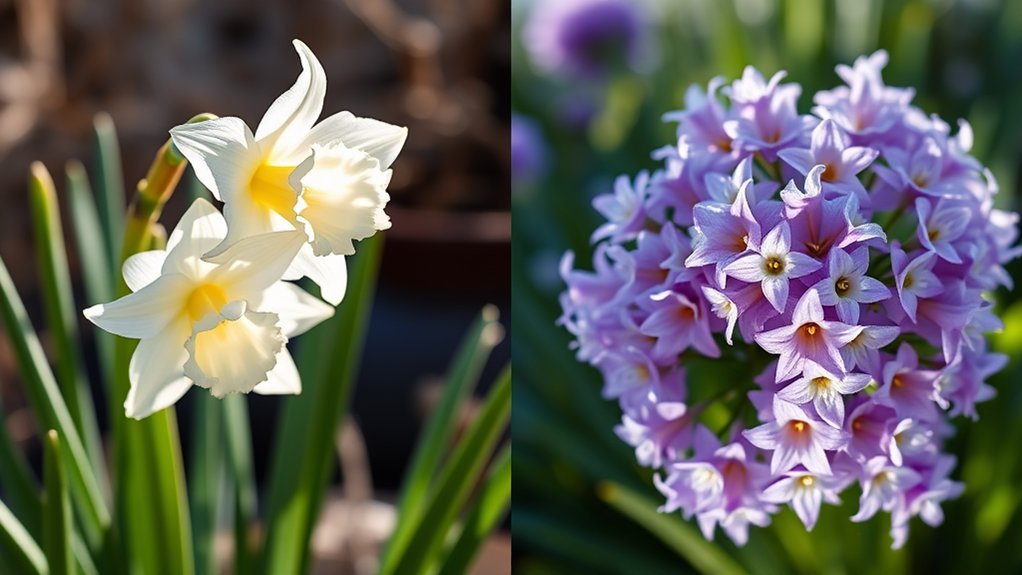
As I explore the reasons behind having two birth flowers for March, I find the differences between the daffodil and the jonquil particularly remarkable.
Each flower carries its own unique symbolism and significance, reflecting diverse aspects of renewal and personal expression.
Understanding these distinctions can shed light on the rich meanings associated with being born in this vibrant month.
Daffodil and Jonquil Differences
While both daffodils and jonquils share a common ancestry in the Narcissus genus, their distinct characteristics and symbolic meanings differentiate them markedly.
Daffodil blooms feature a trumpet shape, typically presenting one flower per stem, while jonquils bloom with multiple smaller, fragrant flowers, enhancing their visual appeal.
As members of the Narcissus family, they symbolize rebirth and new beginnings, but daffodils often evoke joy and positivity, whereas jonquils convey affection and optimism.
With daffodils thriving in USDA zones 3-9 and jonquils preferring zones 4-9, having two birth flowers for March offers varied interpretations of innocence and purity.
Symbolism and Significance
Understanding why March boasts two birth flowers—daffodils and jonquils—reveals the rich tapestry of symbolism and significance woven into these blooms.
Both belong to the Narcissus genus, embodying themes of rebirth and new beginnings as winter fades. The daffodil, with its vibrant single bloom, symbolizes joy, positivity, and friendship, while the jonquil's fragrant clusters signify affection and optimism.
Together, they enhance March's narrative of renewal and hope. Additionally, the daffodil is linked to good fortune, and the jonquil represents purity, enriching their meanings.
This duality offers a broader spectrum of symbolism for those celebrating their March birthdays.
Daffodil Birth Flower
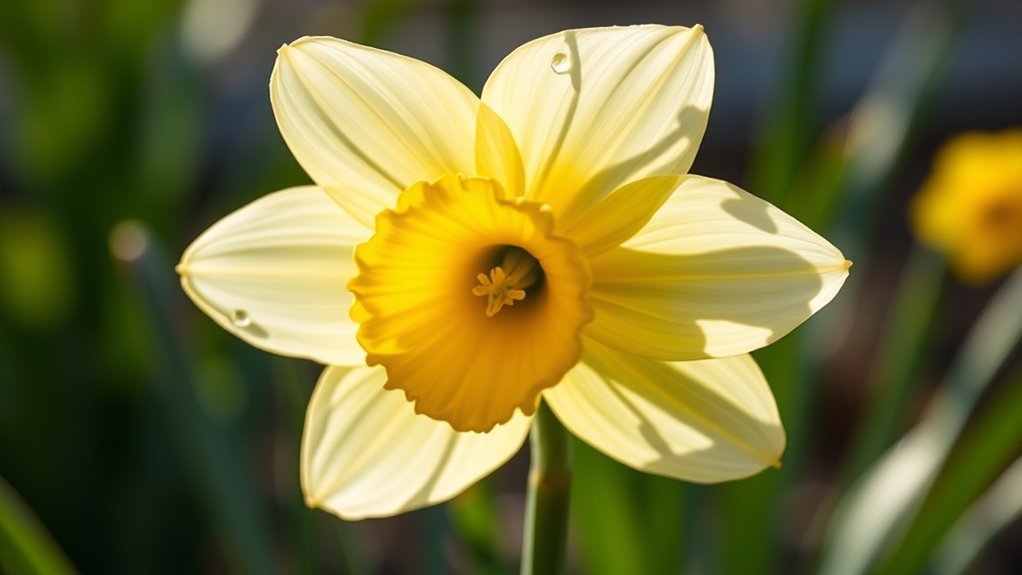
Daffodils, the official birth flower for March, embody a rich symbolism of new beginnings and joy that resonates deeply with those celebrating their birthdays this month.
Daffodils represent optimism and happiness, making them a thoughtful gift. March has two birth flowers, yet the daffodil, particularly Narcissus jonquilla, stands out for its vibrant trumpet-shaped blooms.
Daffodils symbolize joy and optimism, making them the perfect gift for those born in March.
These perennial plants thrive in well-drained soil and full sun, blooming in the spring after being properly planted in the fall.
With a lifespan of up to 50 years, daffodils offer a lasting reminder of renewal and the joys that come with each new season.
Meanings & Symbolism by Color

Colors in daffodils carry profound meanings, each hue reflecting distinct emotions and sentiments. As the March birth flower, they embody various symbols that resonate deeply. Here's a breakdown:
| Color | Meaning |
|---|---|
| Yellow | Friendship, joy, positivity |
| White | Innocence, purity |
| Orange | Enthusiasm, passion |
| Pink | Admiration, love |
Each color of daffodils speaks to different aspects of human connection, making them a versatile choice for celebrating relationships. Understanding these meanings and symbolism empowers us to express heartfelt emotions through the beautiful daffodil.
Historical and Cultural Significance
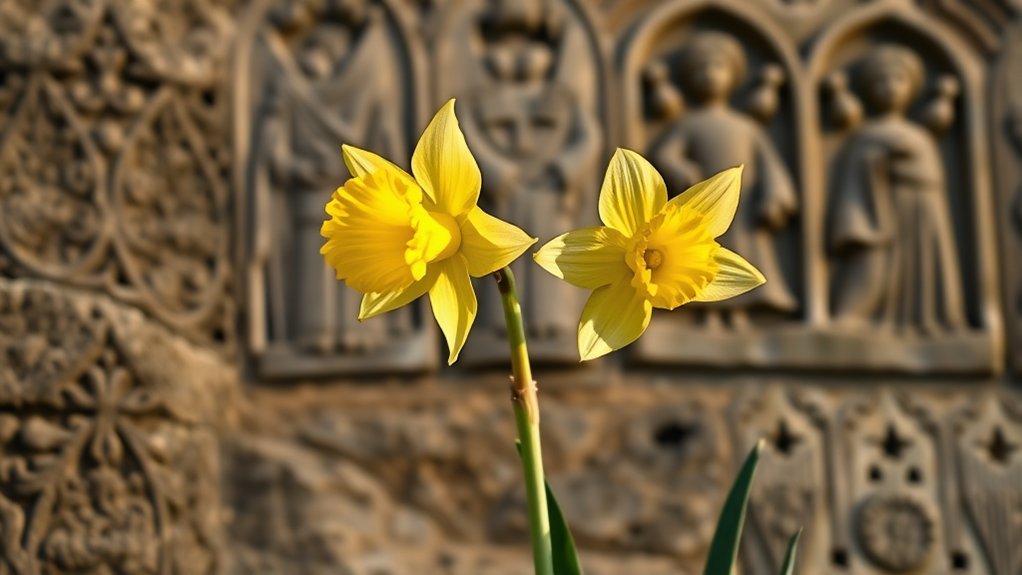
As we explore the historical and cultural significance of daffodils, it's fascinating to note their ancient medicinal uses and the symbolism they carry in various literary works.
These flowers not only play a role in cultural celebrations, like St. David's Day in Wales, but also reflect deeper themes of beauty and rebirth in mythology.
Ancient Medicinal Uses
While many may simply admire daffodils for their vibrant blooms, their historical and cultural significance as medicinal plants is both fascinating and profound.
Daffodils have been cultivated since ancient times, with Greeks and Romans harnessing their medicinal properties to treat ailments like tumors. Their bulbs were often tied to folk remedies, symbolizing good luck and prosperity.
Additionally, the irritant sap of daffodils served to protect gardens from herbivorous animals. Even today, the compound galantamine, derived from these flowers, plays an essential role in developing treatments for Alzheimer's disease, illustrating their enduring relevance in both historical and modern medicine.
Symbolism in Literature
Although daffodils are often admired for their beauty, their representation in literature reveals a deeper cultural and historical significance.
Renowned poets like William Wordsworth have immortalized daffodils, celebrating their symbolism of renewal in works such as "I Wandered Lonely as a Cloud." In Chinese culture, these flowers herald good fortune on New Year's Day, while in medieval times, their drooping form symbolized death, embodying life's duality.
Recognized as Wales' national flower, daffodils are worn on St. David's Day, reflecting pride and heritage. Consequently, they transcend mere aesthetics, intertwining with themes of hope, loss, and cultural identity in literature.
Cultural Celebrations and Traditions
Daffodils hold a prominent place in various cultural celebrations and traditions, reflecting their rich historical significance.
In Wales, wearing daffodils on St. David's Day (March 1) symbolizes national pride and reverence for its patron saint. Meanwhile, in China, the blooming of daffodils on New Year's Day heralds good fortune and prosperity.
Historically, during the Victorian era, they represented chivalry and unrequited love, enriching art and literature.
Universally, daffodils embody hope and renewal, marking the end of winter in spring festivals. Their cultural significance remains a reflection of the enduring beauty and inspiration these March flowers provide.
Growing and Care Tips
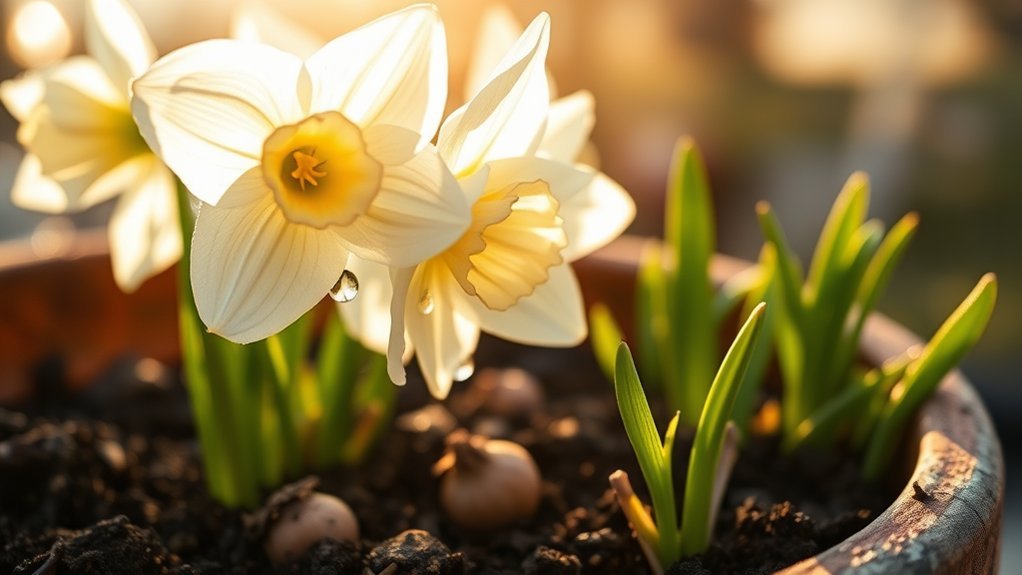
To successfully grow daffodils and jonquils, it's important to plant their bulbs in the fall, ideally before the first frost.
These flowers thrive in sunny spots with well-drained soil, so choose your location wisely.
During the growing season, I guarantee moderate watering to prevent root rot, especially until the foliage begins to die back.
After flowering, I remove faded blooms but leave the foliage for at least six weeks to nourish the bulb for future growth.
With proper care, daffodils can last up to 50 years, making them a perfect choice for March birthday flower delivery and long-term garden beauty.
Jonquil Birth Flower
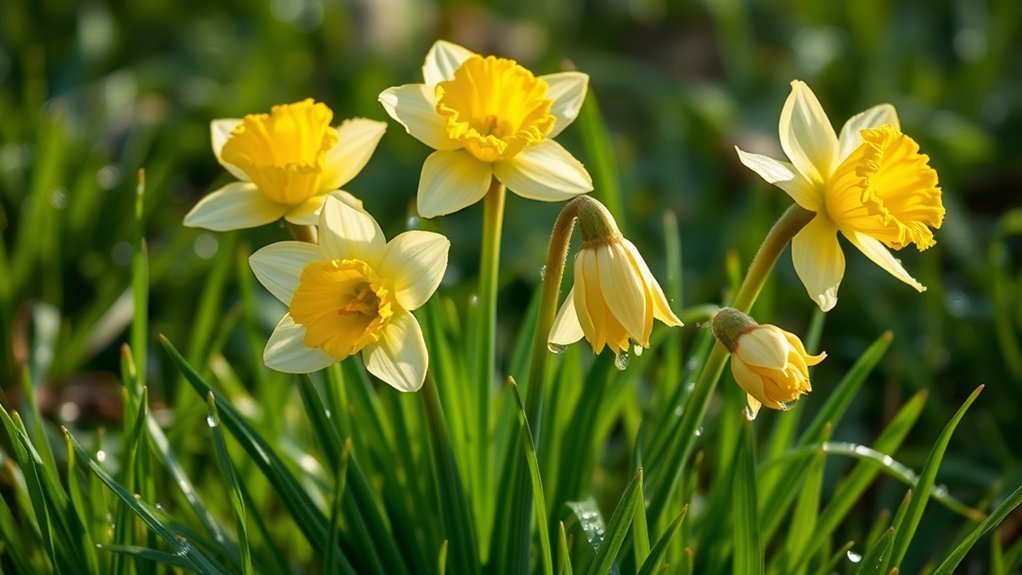
Jonquils, with their distinctive rush-like leaves and delightful fragrance, captivate gardeners and flower enthusiasts alike.
These charming blooms, scientifically known as Narcissus jonquilla, symbolize rebirth and new beginnings, making them perfect as March birth flowers.
- Hardy in USDA zones 4-9
- Thrive in well-drained soil
- Prefer sunny locations
- Typically bloom mid to late spring
Reaching heights of 8-16 inches, each stem often showcases 2-6 fragrant yellow flowers.
The name "jonquil" reflects their unique foliage, distinguishing them within the Narcissus family.
Embrace the beauty of jonquils this March and celebrate life's fresh starts.
Frequently Asked Questions
Why Does March Have 2 Birth Flowers?
I've found that March has two flowers due to its rich historical significance and cultural variations. Understanding their symbolism, along with flower gardening tips and zodiac connections, enhances our appreciation of these blooms' diversity and meaning.
Is March a Daffodil or a Cherry Blossom?
When considering March's floral significance, I find the daffodil embodies renewal, symbolizing joy and new beginnings, while cherry blossoms highlight beauty's transience. Both seasonal blooms enrich March celebrations, yet daffodils hold the primary recognition.
What Is March Pisces' Birth Flower?
Imagine a vibrant garden where Pisces traits bloom—daffodils symbolize joy and renewal. In floral arrangements, their bright colors reflect zodiac connections, embodying the significance of March and celebrating the freedom of new beginnings.
What Is the Meaning of the Jonquil Flower?
The jonquil symbolizes rebirth and hope, with yellow signifying affection and optimism. Historically significant, it's cultivated for beauty and medicinal uses. When planting, guarantee well-drained soil and sunlight for ideal growth and vibrant blooms.
Conclusion
To sum up, March's birth flowers, the daffodil and jonquil, both embody renewal and hope, reflecting the vibrant spirit of spring. While they share similarities, their distinct meanings and colors add depth to their symbolism. As the saying goes, "April showers bring May flowers," but these March blooms remind us that beauty and resilience often emerge first. By understanding their significance and care, we can appreciate these blooms not just for their beauty, but for the stories they tell.

